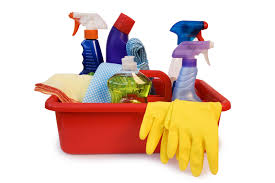Housekeeping :
Attention to general cleanliness, storage and housekeeping can prevent numerous accidents. Specific housekeeping requirements and good housekeeping efforts are a part of the company fire prevention and accident prevention program. All Employees share the responsibility for maintaining good housekeeping practice and following the established housekeeping procedures.
A cluttered workspace can restrict movement in the plant and increase the likelihood of slips and falls. Chances are that when somebody slips on something, it is something that shouldn't be there.
In a recent year over 400,000 reported injuries were the result of poor housekeeping causing slips and falls, and 35 percent of all lost workdays were caused by injuries due to slips and falls. A cluttered workspace can also be a firetrap. Poor housekeeping creates more places for fires to start and provide fuel for fires to feed on. In fact, many industrial fires are the direct result of accumulations of oil soaked, and paint saturated clothing and rags. If there is a fire, clutter can prevent a quick and safe exit and restrict access by fire extinguishing equipment.
Clutter on the job is not only dangerous, it is counter-productive. Quality on the job is hard to maintain when the workspace is crowded and messy. Housekeeping clutter can grow like vines, but it can only grow where it's allowed to grow. When last week's clutter is still in our midst to be stumbled over or pushed aside, the system has broken down. A clean work place should be a common concern for all, but it must be established as such. Identifying common concerns help promote cooperation.
Nobody said housekeeping safety is fun, but it's part of the job and if you let it accumulate then you've got to get out the machete and that is a chore. Teamwork is the key to a clean work area and housekeeping-safety. Everyone must do his part and realize that housekeeping is a shared responsibility. Remember that good housekeeping reduces accidents, improves morale and increases efficiency. Most people appreciate a clean and orderly work place where they can accomplish their tasks without interference or interruption.
Management and Employee Responsibility:
All Employees share the responsibility for maintaining good housekeeping practice and following the established housekeeping procedures. The Manager, Supervisors, Safety Coordinator and Safety Committee will be responsible to monitor housekeeping as part of their facility safety inspection procedures, note any hazards or areas of non-compliance, initiate clean-up procedures and provide follow-up. Management has the additional responsibility to provide disciplinary action when necessary to reinforce compliance with this program.
Smoking Policy:
Smoking is not permitted inside buildings and/or within 50 feet of material storage. This includes all offices, rest rooms, locker rooms, production floor, storage areas, coolers, etc. Smoking is permitted outside in designated areas and in the Smoking Section of authorized break areas before work, after work and during breaks. To prevent fires and keep the grounds neat and orderly, all cigarette/cigar ashes and butts are to be disposed in the provided butt cans or ash-trays only.
Hazards:
Improper housekeeping and material storage can create or hide numerous hazards such as:
- Slip & trip hazards.
- Chemical exposure.
- Contact with sharp objects.
- Fire & Explosion hazards.
- Over loading of storage shelves and bins
Hazard Control:
Offices :
Office areas are to be kept neat and orderly. The following general rules apply to prevent injuries and maintain a professional appearance.
1. All aisles, emergency exits, fire extinguishers, etc., will be kept clear (a minimum of three feet of either side) of material storage (temporary and permanent) at all times.
2. Storage areas will be maintained orderly at all times. When supplies are received, the supplies will be stored properly.
3. Spills will be cleaned-up immediately and wastes disposed of properly.
4. All waste receptacles will be lined with a plastic trash bag to avoid direct contact while handling. Custodial Employees will use rubber gloves and compaction bar when handling wastes.
5. Keep file and desk drawers closed when not attended to avoid injuries. Open only one drawer at a time to prevent tipping of file cabinets.
6. At the end of the business day, turn off all office equipment (area heaters, lamps, coffee-maker, PCs, etc.) and lights to save energy and prevent fires. All space heaters be un-plugged at the end of the day to assure they have been turned-off.
Production Areas :
Production areas will be kept neat and orderly, during operations and as follows:
1. All aisles, emergency exits, fire extinguishers, eye wash stations, etc., will be kept clear (a minimum of three feet in front of and to either side) of product storage, material storage, fork trucks and pallet jacks at all times.
2. Spills will be cleaned up immediately.
3. All process leaks will be reported to supervision and maintenance for immediate repair and clean-up.
4. Utility Employees will be responsible to keep aisles and work floors clear of excessive debris and waste materials during shift operation, between breaks and at shift change when necessary or directed by supervision; however, all Employees are responsible to communicate slippery floors to supervision for immediate clean-up.
5. All refuse and waste materials will be placed in the recognized waste containers for disposal.
Rest Rooms, Locker Rooms and Cafeteria:
Rest rooms, locker rooms and cafeteria are provided as a convenience for all Employees. The following rules will apply:
1. Employees are expected to clean-up after themselves as a common courtesy to fellow Employees.
2. Flammable materials (fire works, explosives, gasoline, etc.) may not stored in lockers or brought on company property.
3. Personal food item will not be stored in lockers or cafeteria overnight.
4. All waste receptacles will be lined with a plastic trash bag to avoid direct contact while handling and Custodial Employees will use rubber gloves and compaction bar when handling wastes.
5. All refuse and waste materials will be placed in the recognized waste containers for disposal.
Maintenance Areas :
1. All aisles, emergency exits, fire extinguishers, etc., will be kept clear (a minimum of three feet of either side) of material storage (temporary and permanent) at all times.
2. Storage Areas will be maintained orderly at all times: a. Pipe stock stored horizontally on racks and sorted by size b. Metal stock stored horizontally on racks and sorted by size c. Sheet metal stock stored vertically in racks and sorted by type d. All fittings, etc., stored in bins on shelves and sorted by type and use e. All flammables stored in OSHA-approved Fire Cabinets and self-closing cans where necessary .
3. Spills will be cleaned-up immediately by the person responsible and wastes disposed properly.
4. All refuse and waste materials will be placed in the recognized waste containers for disposal.
Click the below link to implement good house keeping procedures

House keeping guidelines- 5S Terminology